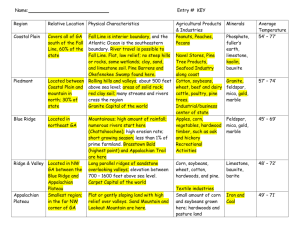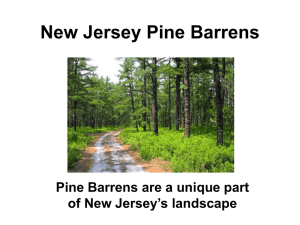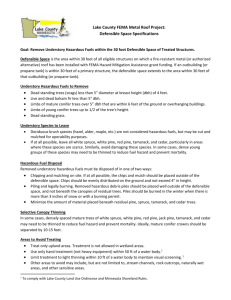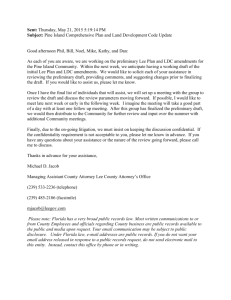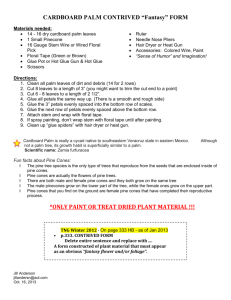Category 14 - USDA Forest Service
advertisement
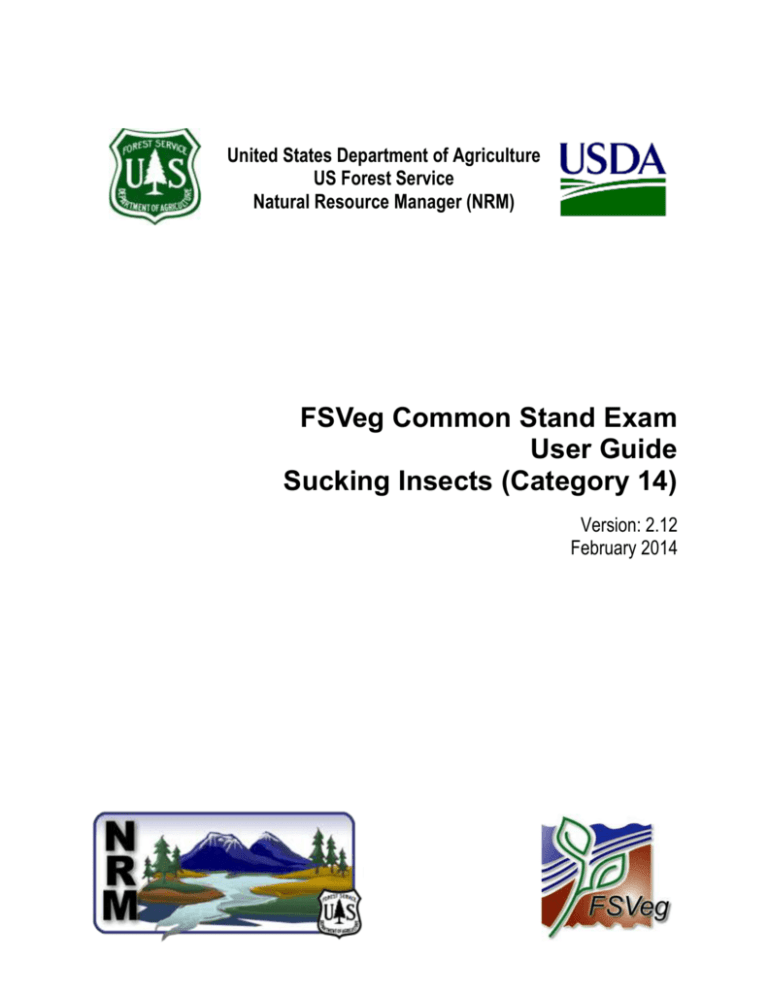
United States Department of Agriculture US Forest Service Natural Resource Manager (NRM) FSVeg Common Stand Exam User Guide Sucking Insects (Category 14) Version: 2.12 February 2014 TABLE OF CONTENTS (14-001) Scale Insects ..................................................................... 4 (14-002) Western Larch Woolly Aphid ............................................. 4 (14-003) Balsam Woolly Adelgid ...................................................... 4 (14-004) Hemlock Woolly Adelgid .................................................... 6 (14-005) Spiraling Whitefly .............................................................. 6 (14-006) Aphid ................................................................................. 7 (14-007) Pine Spittlebug .................................................................. 7 (14-008) Western Pine Spittlebug .................................................... 8 (14-009) Saratoga Spittlebug ........................................................... 9 (14-010) Spittlebug ........................................................................ 10 (14-011) Wax Scale ........................................................................ 10 (14-012) Pine Needle Scale ............................................................ 10 (14-014) Giant Conifer Aphids ........................................................ 12 (14-015) White Pine Aphid ............................................................. 13 (14-016) Beech Scale ..................................................................... 13 (14-017) Spruce Aphid ................................................................... 14 (14-018) Woolly Apple Aphid ......................................................... 15 (14-019) Striped Mealybug ............................................................ 15 (14-020) Elongate Hemlock Scale .................................................. 16 (14-021) Coconut Red Scale ........................................................... 16 (14-023) Leucaena Psyllid .............................................................. 16 (14-025) Egyptian Fluted Scale ...................................................... 17 FSVeg Common Stand Exam User Guide i Insects & Diseases: Sucking Insects (Category 14) (14-026) Lecanium Scale................................................................ 17 (14-028) Oystershell Scale ............................................................. 17 (14-029) Pinyon Needle Scale ........................................................ 18 (14-030) Ponderosa Pine Twig Scale .............................................. 19 (14-031) Pine Twig Scale ............................................................... 19 (14-032) Ponderosa Pine Scale ...................................................... 19 (14-033) Red Pine Scale ................................................................. 19 (14-034) Prescott Scale ................................................................. 20 (14-035) Treehoppers .................................................................... 20 (14-036) Hibiscus Psyllid ............................................................... 20 (14-037) Balsam Twig Aphid .......................................................... 20 (14-038) Hibiscus Mealybug ........................................................... 21 (14-039) Black Pineleaf Scale ........................................................ 21 (14-040) Spruce Spider Mite .......................................................... 22 (14-041) Twig Girdler..................................................................... 23 (14-043) Maple Aphids ................................................................... 23 (14-044) Spruce Bud Scale ............................................................. 24 (14-045) Red Pine Adelgid ............................................................. 24 (14-046) Pine Leaf Adelgid ............................................................. 25 (14-047) White Pine Adelgid .......................................................... 25 (14-048) Pine Bark Adelgid ............................................................ 25 (14-049) Root Aphid....................................................................... 26 (14-050) Mealybug ......................................................................... 26 (14-051) Cottony Maple Scale ........................................................ 26 FSVeg Common Stand Exam User Guide ii Insects & Diseases: Sucking Insects (Category 14) (14-052) Fir Mealybug .................................................................... 27 (14-053) Douglas-Fir Mealybug ...................................................... 27 (14-054) Spruce Mealybug ............................................................. 28 (14-055) Hemispherical Scale ........................................................ 28 (14-056) Woolly Pine Needle Aphid ................................................ 28 (14-057) Steatococcus Scale .......................................................... 29 (14-058) Pear Thrips ...................................................................... 29 (14-059) Mulberry Whitefly ............................................................ 29 (14-060) Tuliptree Scale ................................................................ 30 (14-061) Pine Tortoise Scale .......................................................... 30 (14-062) Citrus Snow Scale ............................................................ 31 (14-063) Birch Aphid ...................................................................... 32 (14-065) Causarina Spittlebug ....................................................... 33 (14-066) Giant Bark Aphid ............................................................. 33 (14-067) Woolly Pine Scale ............................................................ 33 (14-068) European Elm Scale ......................................................... 33 (14-069) Elm Scurfy Scale .............................................................. 34 FSVeg Common Stand Exam User Guide iii Insects & Diseases: Sucking Insects (Category 14) (14-001) SCALE INSECTS Host: Nursery stock and seed orchards Injury: Trees with poor vigor or with branch and crown dieback should be examined closely for scales. Scale feeding may cause some abnormal plant growth at the point of attack, such as stunting of leaf or shoot growth, leaves turning yellow or red, and branch gouting. Other symptoms to look for are early leaf drop, dieback, or “flagging” of newly formed terminals, branch ends, and new leaves. Ring-like swellings or pits in the bark cause a rough appearance of branches. Heavy infestations will kill trees. Sooty mold and ants frequenting a tree are good indications of scale infestations. Description: Scale insects vary in shape and form. There are soft-bodied, hardbodied, or armored scales. They may resemble a small turtle or oyster shell, or even part of the bark of the tree. Some scales are white and very obvious, others are dull and perfectly match their host’s color. Therefore, close examination is very important. They can range from 1/50 to 1/10 inch in length. Scale insects can be found on any part of a tree. (14-002) WESTERN LARCH WOOLLY APHID Species: Adelges oregonensis Host: Western larch Range: Washington, Oregon, Montana Injury: On spruce, it causes small globular, cone-shaped terminal galls; on larch, it feeds on the twigs and needles Description: It has five pairs of abdominal spiracles. The insects occur as white, cottony tufts on the bark of the trunk, branches, twigs, needles, and cones. (14-003) BALSAM WOOLLY ADELGID Species: Adelges piceae Host: Pacific silver fir, balsam fir, Frasier fir, grand fir, subalpine fir Range: Washington and Oregon; northeastern states (except northern parts of Maine); southern Appalachians FSVeg Common Stand Exam Users Guide 4 Insects & Diseases: Sucking Insects (Category 14) Injury: This small, sucking insect feeds on stems, branches, or twigs. Nymphs feed on the bark of all parts of the tree, injecting a chemical that causes abnormal cell division. This causes galls or swellings at twig tips and dense, red wood (similar to compression wound) on the stem. Stems of heavily attacked trees appear white because of the white, cottony masses that surround the adults during summer months. All sizes of trees are attacked, but infestations may be concentrated on the stems or in the crowns. Stem-attacked trees may be killed after 23 years of heavy feeding. Figure 1: Adult balsam woolly adelgid on tree trunk Figure 2: Stem swellings from balsam woolly adelgid FSVeg Common Stand Exam Users Guide 5 Insects & Diseases: Sucking Insects (Category 14) Figure 3: Balsam woolly adelgid eggs (14-004) HEMLOCK WOOLLY ADELGID Species: Adelges tsugae Range: Alaska, Washington, Oregon, California Injury: Occur as white, cottony tufts on the bark and on the twigs among the needles Description: It has five pairs of abdominal spiracles. Figure 4: Woolly aphids on spruce (14-005) SPIRALING WHITEFLY Species: Aleurodicus disperses Host: Plumeria, guava, sea grape, coconut Range: Guam, Hawaii, Northern Marianas, Belau, Pohnpei FSVeg Common Stand Exam Users Guide 6 Insects & Diseases: Sucking Insects (Category 14) Injury: The whiteflies reduce the vigor of heavily infested plants, make ornamentals unsightly, and secrete honeydew on which sooty mold grows. Heavy infestations can reduce yields in fruit trees. Description: The whitefly is a small, dusty-white insect, which resembles a tiny moth. The eggs are laid on the lower surface of leaves in a characteristic spiral pattern, which gives the whitefly its name. The nymphs are covered with a waxy, white substance, and they secrete a sticky juice called honeydew. Whiteflies can be extremely abundant and can cover the entire lower surface of leaves. (14-006) APHID Species: Aphididae spp. Host: All hardwoods and conifers Range: Continental United States Injury: Aphids have piercing mouth parts through which they feed on sap from nearly all parts of host plants—foliage, buds, flowers, fruits, twigs, and roots. They can be found almost anywhere on a tree, particularly on new growth. Heavy infestations distort foliage, cause terminal dieback, reduce tree vitality, weaken the tree, and cause branch and crown dieback. In young trees and seedlings, mortality can occur from heavy infestations. Aphids are usually of greatest concern in nurseries. Description: The color ranges from almost colorless to green, yellow, or black. Most are wingless, however winged adults may be observed in summer. Presence of sticky exudates and a large number of ants probably indicate aphids are also present. Aphids are small and soft-bodied. Most aphids are pear-shaped, with a pair of cornicles at the posterior of the abdomen. (14-007) PINE SPITTLEBUG Species: Aphrophora parallela Host: Scots pine Secondary host: Pitch pine, eastern white pine, jack pine, slash pine, Virginia pine, loblolly pine, Norway spruce, white spruce, red spruce, balsam fir, eastern hemlock Range: Eastern states from New England to the Lake States, Arkansas, Florida, Alabama FSVeg Common Stand Exam Users Guide 7 Insects & Diseases: Sucking Insects (Category 14) Injury: Damage includes yellowing of the foliage, growth loss, twig mortality, and in heavy infestation, tree death. Branch flagging progresses from new to old growth on each branch. Lower branches are the first to show effects of feeding. These infestations are identified by the presence of spittle masses. Blackened foliage, caused by growth of sooty mold fungus, may indicate an old infestation. Description: Eggs are deposited at the base of terminal buds during July and August. When they hatch the following May, the nymphs move to the twig tips and begin feeding. The nymphs keep covered with spittle at each new location as they move toward the main trunk. Young nymphs are orange and black, while full-grown nymphs range from light brown to black. Mature nymphs leave the spittle and migrate to the needles, where they transform into winged adults. (14-008) WESTERN PINE SPITTLEBUG Species: Aphrophora permutata Host: Pine, Monterey pine, Douglas-fir, hemlock, spruce Range: Western states Injury: Not a significant source of damage, but some feeding on needles does occur. Description: The adults are robust, mottled brown, heavily punctured, and about 10 mm long. Adults jump and fly readily when disturbed. They are readily recognized by the spittle-like froth that surrounds the nymphs as they feed. Figure 5: Western pine spittlebug nymphs and spittle FSVeg Common Stand Exam Users Guide 8 Insects & Diseases: Sucking Insects (Category 14) (14-009) SARATOGA SPITTLEBUG Species: Aphrophora sratogensis Host: Red pine, jack pine Secondary host: Eastern white pine, pitch pine, tamarack, balsam fir Range: California, eastern states from Maine to Minnesota, and south through the Appalachians to Florida Damage: Young trees between 2 and 15 feet tall are injured. The first symptoms are one or more reddish or reddish-brown (flagged) branches in the upper crown. Scraping the outer bark from the 2year-old internodes of the flagged branches will reveal tan or brown flecks on the surface of the wood and inner bark, which confirms the injury caused by this spittlebug. These puncture-wounds or scars develop at the location of adult feeding. If these puncture-wounds are numerous, the nutrient transport in the branches is restricted and the branches die, resulting in the flagging symptom. Continued heavy feeding results in increased flagging, top kill, stem deformity, and tree death. The worst injury always occurs where there are abundant alternative hosts for the nymphs. The nymphs require two alternate hosts for their development. The early stages or instars feed on herbaceous species of plants of the forest floor such as brambles (raspberry and blackberry), orange hawkweed, everlasting, aster, and many others. Older nymphs feed on sweet-fern and willow sprouts. Figure 6: Adult Saratoga spittlebug Figure 7: Saratoga spittlebug puncture wounds FSVeg Common Stand Exam Users Guide 9 Insects & Diseases: Sucking Insects (Category 14) (14-010) SPITTLEBUG Species: Cercopidae Description: Shortleaf pine, longleaf pine, red pine, eastern white pine, Scotch pine, loblolly pine, Virginia pine (14-011) WAX SCALE Species: Ceroplastes sp. Host: Hawthorne, holly, other ornamental trees Range: Pacific Islands, Hawaii, Texas Injury: Remove large quantities of plant sap. Sticky honeydew, secreted by these scale insects, is colonized by a sooty mold. Description: Globular and coated with a heavy layer of wet beige, pinkish, whitish, or grayish wax. From the top view they appear rectangular, oval, or lobed at the base and may grow to over 1/8 inch to almost ¼ inch in diameter. (14-012) PINE NEEDLE SCALE Species: Chionaspis pinifoliae Host: Lodgepole pine, ponderosa pine, slash pine, mugho pine, Austrian pine, red pine, eastern white pine, Scotch pine, Virginia Pine Secondary host: Englemann spruce, subalpine fir, Douglas-fir Injury: Look for white or yellowish oyster-shaped scales on needles. Lower branches tend to have heaviest populations. Yellowing and dieback can occur when populations are heavy, or trees may look gray. Nymphs suck fluid from needles turning them yellow brown. Heavy populations can kill trees after a few years. Scales may be seen on needles any time of the year. Scale infestations are often associated with excessive road dust or other factors affecting tree vigor. Description: Scales are white, 1/8th inch long, elongated oval, and are yellow at the apex. Rusty brown eggs are under the scales in the winter. FSVeg Common Stand Exam Users Guide 10 Insects & Diseases: Sucking Insects (Category 14) Figure 8: Twig infested with pine needle scales Figure 9: Tree affected with pine needle scales Figure 10: Pine needle scale crawlers FSVeg Common Stand Exam Users Guide 11 Insects & Diseases: Sucking Insects (Category 14) Figure 11: Adult pine needle scale with parasite emergence hole Figure 12: Pine needle scales on needles (14-014) GIANT CONIFER APHIDS Species: Cinara spp. Host: Eastern redcedar, balsam fir, white fir, grand fir, California red fir, subalpine fir, Douglas-fir, Engelmann spruce, black spruce, blue spruce, white spruce, Sitka spruce, Rocky Mountain juniper, western larch, western hemlock, cypress, cedar, Virginia pine, loblolly pine, jack pine, lodgepole pine, shortleaf pine, slash pine, longleaf pine, ponderosa pine, red pine, pond pine, pitch pine Injury: They pierce the bark with their long feeding tubes and feed on sap from shoots, twigs, branches, stems, and roots. Most species feed in groups and are usually attended by ants, which feed on the droplets of excreted liquid. Description: Aphids vary in color from gray to brown or black, and are less than 5 mm long. Eggs are blackish and are laid singly or in rows on the needles. FSVeg Common Stand Exam Users Guide 12 Insects & Diseases: Sucking Insects (Category 14) Figure 13: Giant conifer aphid adults (14-015) WHITE PINE APHID Species: Cinara strobe Host: Eastern white pine Range: New England to the Lake States, and California Injury: Serious damage only occurs in plantations. There is a blackening of twigs and branches caused by a sooty mold. The mold grows on the large amounts of honeydew produced by the feeding aphids. Description: Winged females are about ¼ inch long. After laying eggs in the fall, they turn jet black. (14-016) BEECH SCALE Species: Cryptococcus fagisuga Host: Beech Range: Beech growing areas of new England, eastern New York, Pennsylvania, New Jersey FSVeg Common Stand Exam Users Guide 13 Insects & Diseases: Sucking Insects (Category 14) Injury: Large trees, over about 8 inches in diameter, succumb more readily than small ones. Beginning in midsummer, the insects deposit pale yellow eggs on the bark in strings of four to eight, attached end-toend. The eggs usually begin to hatch in late summer and continue hatching until early winter. The wingless larvae (also called crawlers or nymphs) emerge from the eggs with well-developed legs and antennae. Some larvae remain under the females, which die after the eggs are deposited. Some migrate to cracks and other protected areas; others are washed down or fall to the ground where most of them die; and still others are carried, usually by wind, to other beech trees. If a suitable location is found, the insect forces its tubular stylet into the bark and begins to feed. It then transforms into a secondstage nymph, without legs and covered with wool-like wax. The insect over winters in this stage and, in the spring, molts to become an adult female. Description: The scale is a soft-bodied insect. At maturity, it is yellow, elliptical, and 0.5 to 1.0 mm long. It has reddish-brown eyes, a 2 mm stylet, rudimentary antennae and legs, and numerous minute glands that secrete a white “wool-like” wax. There are no male scales; reproduction is parthenogenetic. Figure 14: Beech scale nymph (about 0.3 mm long) (14-017) SPRUCE APHID Species: Elatobium abietnum Host: Sitka spruce Secondary host: Pine, Douglas-fir Range: Alaska to California Injury: It feeds gregariously, sucking sap from the old needles. The lower and more shaded portions of the crown are most subject to injury. On heavily infested trees, practically all the old foliage fades slightly, then drops before the new needles begin to expand. FSVeg Common Stand Exam Users Guide 14 Insects & Diseases: Sucking Insects (Category 14) Description: Adults are 1 to 1.5 mm long, olive green, and predominately wingless. The nymphs are lighter green. It is rarely seen because of its small size and feeding habit. Figure 15: Spruce aphids (14-018) WOOLLY APPLE APHID Species: Eriosoma lanigerum Host: Elm and hawthorn Range: Extensively in the west Injury: Leaf curling is evident from early spring to midsummer. When growth begins in the spring, the aphids that have hatched from the overwintered eggs begin to feed on the developing foliage, cuasing the affected leaves to curl. The resulting generations of aphids are produced in these leaves. Although most of the leaf curl occurs in the spring, it may also be noticeable during the summer due to activity of the later generations. The woolly masses of the aphid are found on the branches and heavy attacks kill small branches. Description: Aphids are purple and are clothed with a white woolly, waxy covering. There are several generations annually. (14-019) STRIPED MEALYBUG Species: Ferrisia vergata Host: Magnolia Range: Maryland, Pennsylvania, Virginia, Alabama Injury: Young nymphs feed on tender growth, such as flower buds; later on all parts of the plant except the main stem and roots. FSVeg Common Stand Exam Users Guide 15 Insects & Diseases: Sucking Insects (Category 14) Description: The adult is covered with flossy threads, much longer than the body. (14-020) ELONGATE HEMLOCK SCALE Species: Fiorinia externa Host: Balsam fir, Englemann spruce Range: New York, Massachusetts, Connecticut, Rhode Island, New Jersey, Maryland, Virginia, Pennsylvania, Ohio Injury: Infested hemlock takes on a mealy, white-washed appearance in the spring and fall. Needles drop prematurely and twigs and branches are killed on heavily infested trees. Description: Live under scales composed of cast skins of earlier stages, held together by waxy excretions of the insect. the terminal segments of the body are fused and strongly chitinized. Adult females are small, flattened, disc-like, and legless. Adult males and their scale coverings are usually elongated. (14-021) COCONUT RED SCALE Species: Furcaspis oceanica Host: Pacific Islands including Hawaii (14-023) LEUCAENA PSYLLID Species: Heteropsylla cubana Host: Leucaena species Range: Pacific Islands including Guam and Hawaii Injury: The damage looks similar to that of typhoons. The small flying psyllids feed on juvenile leaves causing total defoliation once the older leaves drop in maturity. Because of the extensive damage done to the apical meristems, stunting occurs. If the damage is too extensive, stunting is followed by dieback. FSVeg Common Stand Exam Users Guide 16 Insects & Diseases: Sucking Insects (Category 14) (14-025) EGYPTIAN FLUTED SCALE Species: Icerya aegyptiaca Host: Palms, breadfruit Range: Pacific Islands including Hawaii (14-026) LECANIUM SCALE Species: Lecanium spp. Host: Hickory, black walnut, poplar, birch, beech, oak, willow, poplar, maple, honey locust, sycamore Range: Widely distributed in the United States Injury: Heavy scale populations secrete tremendous amounts of honeydew during the early summer, and a sooty mold develops. The trees lose vigor and appear unhealthy. Small branches may be killed. (14-028) OYSTERSHELL SCALE Species: Lepidosaphes ulmi Host: Ash, white ash, maple, silver maple, birch, beech, willow, sycamore, poplar, quaking aspen Range: Throughout the United States Injury: Look for tiny brown to gray oyster shell-shaped scales, usually densely packed on the bark. Foliage may appear thin and chlorotic and there may be areas of the crown that lack leaves or where there are scattered clumps of leaves, dead and dying branches, and abnormally small or discolored leaves. Close examination of the twigs reveals a flattened, elongated brownish bump that looks like a miniature oyster shell. Description: These femal scales are about 1/8 inch long. Males, which have two wings, antennae, and eyes but no mouth, are rare. The female lays eggs under her shell in autumn and they hatch in late May. The crawlers locate a favorable feeding site, insert their mouthparts and begin to feed. As the insect grows, the shell covering increases in size so that the body is always protected. The female loses her legs and eyes after molting and becomes a lump with a mouth. Her body is filled with 20 to 100 eggs, which are laid in late autumn. FSVeg Common Stand Exam Users Guide 17 Insects & Diseases: Sucking Insects (Category 14) (14-029) PINYON NEEDLE SCALE Species: Matsucoccus acalyptus Host: Single-leaf pine, pinyon pine, bristlecone pine, sugar pine, foxtail pine Range: Southern Idaho, Utah, California, Arizona, New Mexico, Colorado, Nevada Injury: Repeated, heavy scale infestations leave the trees with only a few needles, clustered at the tips of branches. Needle length is greatly reduced. Description: Scales look like small, black, bean-shaped, motionless objects on the needles of infested trees. Full-grown immature scales are approximately 1.5 mm in length and 0.7 mm in width and thickness. Figure 16: Mature female pinyon needle scale Figure 17: Pinyon needle scale egg mass FSVeg Common Stand Exam Users Guide 18 Insects & Diseases: Sucking Insects (Category 14) (14-030) PONDEROSA PINE TWIG SCALE Species: Matsucoccus bisetosus Host: Ponderosa pine, Jeffrey pine, lodgepole pine, digger pine, Monterey pine Range: California, Oregon, Colorado Injury: Feeds on twig axils, on twigs and branches, and on the trunks of trees of all ages. Heavily infested trees are characterized by twig killing and by needles that are short, pale, and reduced in numbers. Description: The adult females and winged males emerge early in the spring. The females settle singly under bark scales, secrete wax, and lay eggs. The first instar larvae have legs. (14-031) PINE TWIG SCALE Species: Matsucoccus californicus Host: Ponderosa pine, Jeffrey pine Range: California, Arizona Injury: Feeds on twigs, in bark crevices, and under thick bark. Heavily infested trees are characterized by twig killing and by needles that are short, pale, and reduced in numbers. (14-032) PONDEROSA PINE SCALE Species: Matsucoccus degeneratus Host: Ponderosa pine Range: Arizona Injury: Feeds within the needle sheath and at the base of the needle bundle. (14-033) RED PINE SCALE Species: Matsucoccus resinosae Host: Red pine FSVeg Common Stand Exam Users Guide 19 Insects & Diseases: Sucking Insects (Category 14) Range: Connecticut, southeastern New York, northern New Jersey Injury: The foliage turns olive green, then yellow, and, finally, brick red when the tree dies. The bark and branches of heavily infested trees appear swollen and cracked, and there is a patch of dead tissue beneath each feeding scale. (14-034) PRESCOTT SCALE Species: Matsucoccus vexillorum Host: Ponderosa pine Range: California, Nevada, Arizona, New Mexico, Colorado Injury: Feeds on bark at the base of needle bundles, in axils of twigs and branches; and on small branches in bark crevices. (14-035) TREEHOPPERS Species: Membracidae Description: Treehoppers are characterized by the prolongation of the pronotum backward and above the abdomen. The hind legs are long and adapted for jumping, and the female’s ovipositor is long and saw-like. (14-036) HIBISCUS PSYLLID Species: Mesohomotoma hibisci Range: Pacific Islands including Hawaii (14-037) BALSAM TWIG APHID Species: Mindarus abietinus Host: Balsam fir, white fir, grand fir, Pacific silver fir, Fraser fir, subalpine fir, Englemann spruce, white spruce blue spruce, juniper Range: Transcontinental FSVeg Common Stand Exam Users Guide 20 Insects & Diseases: Sucking Insects (Category 14) Injury: Curling and twisting of needles, distortion of twigs, and presence of aphid colonies covered with white waxy material. Infested tips may be sticky and shiny with honeydew or black with sooty mold. In early spring, look for tiny pale (milky) green wingless stem mothers, often on needle undersides. You may detect them from the shiny drop of honeydew. In fall and winter, the tiny flattened black eggs covered with bits of whitish wax may be seen with a hand lens near buds. Shoot and needle injury gives the foliage a ruffled appearance. Description: The eggs hatch in late April or early May, and first generation nymphs feed on needles near the buds. Next generations feed on needles of the developing shoots in May and June, excreting masses of waxy white “wool” and large quantities of sticky honeydew. The adults are 3 mm long. (14-038) HIBISCUS MEALYBUG Species: Nipaecoccus vastator Host: Leucaena species Range: Pacific Islands including Hawaii and Guam Injury: These powdery white bugs feed on the tender portions of the plant and anchor themselves on the under surface of leaves for protection. The bugs feed on the leaves and drop excreta on the lower canopy, which is attacked by fungus and other microorganisms. This leaves a black, sooty appearance on the lower leaves. (14-039) BLACK PINELEAF SCALE Species: Nuculaspis californica Host: Ponderosa pine, Jeffrey pine, sugar pine, Monterey pine, knobcone pine, digger pine Secondary host: Douglas-fir Range: Throughout the States Injury: Sustained heavy feeding for several years progressively weakens and can kill trees of all sizes. Persistent infestations usually cause sparse short foliage on twig tips. Needles turn blotchy, yellow-green, and may drop off. Sites on needles infested tend to become spotted or blotched with yellow patches. Description: Scale coverings are gray to black. The insect and eggs under the scale are yellow. FSVeg Common Stand Exam Users Guide 21 Insects & Diseases: Sucking Insects (Category 14) Figure 18: Black pineleaf scales Figure 19: Adult black pineleaf scales Figure 20: Adult pine leaf scales (14-040) SPRUCE SPIDER MITE Species: Oligonychus ununquis FSVeg Common Stand Exam Users Guide 22 Insects & Diseases: Sucking Insects (Category 14) Host: Hemlock, spruce, Englemann spruce, cedar, Douglas-fir, redwood, giant sequoia Secondary host: Pine, juniper Range: All States Injury: Heavily infested trees often have grayish to yellowish foliage, because the immature and adult mites feed by rupturing cells and sucking their contents. This results in needles with a characteristic mottled appearance. Extensive webs, which usually accompany feeding, collect dirt and dust to add further to the gray appearance of the foliage. When cool weather creates conditions favorable for population buildups, complete defoliation can occur. Description: Adult mites are less than 1/25th inch long. They are translucent, but appear yellow, green, orange, or red depending on the foods and wastes accumulated in their bodies. (14-041) TWIG GIRDLER Species: Oncideres cingulata Host: Hickory, persimmon, elm, oak, honey locust, poplar, dogwood Range: Eastern and southwestern States Injury: Adults feed on the tender bark and tips of twigs. On heavily infested trees dozens of branches may be girdled and severed; often many of them hang on for long periods before dropping to the ground. Description: Adults are grayish brown and about 15 mm long. The front of the head is clothed with fine golden hairs; the elytra are clothed with gray, fine hairs and are marked with scattered yellow spots. Full-grown larvae are up to 18 mm long. (14-043) MAPLE APHIDS Species: Periphyllus spp. Host: Maple, sugar maple, bigleaf maple, boxelder Range: Wherever maples are found Description: Brown to green, 2 to 3 mm long, have abundant spine-like hairs. FSVeg Common Stand Exam Users Guide 23 Insects & Diseases: Sucking Insects (Category 14) (14-044) SPRUCE BUD SCALE Species: Physokermes piceae Host: Norway spruce, white spruce, balsam fir Secondary host: Pine Range: Northeastern states, Alaska, California Injury: Heavily infested trees are weakened by the feeding, which cause needle loss, and a black mold develops in the liquid excretion. This excretion draws bees and ants. Immature individuals cluster around terminal buds, their feeding tubes inserted in the sap stream. Description: In early summer, females are about 3mm in diameter. Eggs are formed under the scale. As they hatch, young crawlers move to the tips of the twigs where they feed until late fall. Figure 21: Spruce bud scale damage (14-045) RED PINE ADELGID Species: Pineus borneri Host: Monterey pine Range: California Injury: Feeds on the bole, branches, and twigs FSVeg Common Stand Exam Users Guide 24 Insects & Diseases: Sucking Insects (Category 14) (14-046) PINE LEAF ADELGID Species: Pineus pinifoliae Host: Western white pine, eastern white pine, Englemann spruce, blue spruce, Sitka spruce, red spruce, black spruce Range: Washington, Oregon, California, Idaho, Montana, Colorado, and in the east where red and black spruce occur Description: Beginning in mid-summer, look for drooping or discolored new lateral shoots on pine. Crawlers will be present on the shoots and remnants of the winged adults may be found lined up on old pine needles, heading toward the needle base, from July to May. This shoot droop may persist into the following year. Heavy populations occur on pine and spruce in alternate years. Trees that survive heavy attacks are usually deformed. On spruce, the insects are tiny and hidden under bud scales or within the numbered years, the winged adults fly from spruce to white pine, where they lay eggs on the old needles, then die. Wingless nymphs emerge from these eggs, crawl to the axes of newly expanding shoots, insert their mouthparts, and begin feeding. The nymphs mature in May of even-numbered years, then fly back to spruce trees where they lay eggs. Because the adelgids stay in groups, they may attack only a few shoots of a white pine tree. If there are too many insects on a shoot, they will starve because they cannot move to another shoot. (14-047) WHITE PINE ADELGID Species: Pineus spp. Host: Jeffrey pine, sugar pine, singleleaf pine, pinyon pine, western white pine, ponderosa pine, lodgepole pine, white spruce, black spruce, Norway spruce, blue spruce, red spruce, Englemann spruce Range: Transcontinental Description: Have four pairs of abdominal spines. They occur as white, cottony tufts on the bark of the trunk, branches, twigs, needles, and cones. (14-048) PINE BARK ADELGID Species: Pineus strobe Host: Eastern white pine, Scots pine, Austrian pine Range: California and the range of the host pines FSVeg Common Stand Exam Users Guide 25 Insects & Diseases: Sucking Insects (Category 14) Injury: Look for white woolly material on trunks, branches, and at the bases of needles in early spring. Heavy infestations may give the bark a white appearance. Under the wax, you may find the dark-colored adelgids. The wax-covered brown eggs are clustered near females. Mature white pines are seldom damaged. Needles turn yellow in younger trees; large patches of white cottony material may cover the tree trunk and branches giving a whitewashed appearance. Description: In the spring, females lay eggs that produce both winged and wingless females. Wingless forms remain on the host tree and reproduce several times. (14-049) ROOT APHID Species: Prociphilus americanus Host: Ash Secondary host: Noble fir, Douglas-fir Range: Oregon Injury: The insects feed on the roots. They are usually attended by ants. They form false falls, mostly on leaves, in which all forms live together. Description: All are covered with a white cottony wax. (14-050) MEALYBUG Species: Pseudococcidae Host: Cypress, juniper, spruce, pine, sycamore, willow Range: Transcontinental Description: Members of this family have mealy or waxy secretions that cover their bodies. Females are elongated oval, and have segmented bodies and well-developed legs. Some species lay eggs, others give birth to live young. (14-051) COTTONY MAPLE SCALE Species: Pulvinaria innumerabilis Host: Silver maple FSVeg Common Stand Exam Users Guide 26 Insects & Diseases: Sucking Insects (Category 14) Secondary host: Poplar, willow, white ash, boxelder, dogwood, black locust, honey locust, sycamore Range: Transcontinental Injury: The nymphs (crawlers) feed on the lower surface of the leaves and twigs. Large white cottony masses, popcorn-like in appearance, may be found in the spring on the twigs and branches. The foliage is covered with honeydew and a sooty fungus. These attacks cause yellowing and early foliage drop, and the death of the twigs. Heavy populations may kill larger branches or an entire tree. Description: The adult females are elongate-oval, brown soft scales, nearly 3/10th inch in length and slightly less in width, with a conspicuous elongate white egg sac. The adult female hibernates on the twigs. Egg masses are produced in the spring. (14-052) FIR MEALYBUG Species: Puto cupressi Host: Monterey cypress, redwood, white fir, subalpine fir, whitebark pine, lodgepole pine, Monterey pine, Englemann spruce, Douglas-fir Range: California, Oregon, Washington, Idaho Injury: It is most damaging to true firs. On heavily infested subalpine fir, the foliage becomes stunted, sickly, and covered with a black mold. Tumor-like swellings develop on the bole, branches, and twigs. Branches in the upper portion of the crown die first. Small trees may be killed, and others reduced in growth. Description: Males have felt-like cocoons in infested twigs. The adult males are winged. Fluffy masses of white waxy threads cover the females and the clusters of eggs. The adult females are 3 to 5 mm long. (14-053) DOUGLAS-FIR MEALYBUG Species: Puto profusus Host: Douglas-fir Range: California Injury: Infests the cracks of bark on the main bole. FSVeg Common Stand Exam Users Guide 27 Insects & Diseases: Sucking Insects (Category 14) Description: Males have felt-like cocoons in infested twigs. The adult males are winged. Fluffy masses of white waxy threads cover the females and the cluster of eggs. The adult females are 3 to 5 mm long. (14-054) SPRUCE MEALYBUG Species: Puto sandini Host: Englemann spruce Injury: Mortality in small trees, growth reduction and deformity in surviving trees. There is heavy sap flow from branches during the second and third year of feeding. Conspicuous yellowing of needles on branches scattered throughout the tree occurs in the third feeding season. Description: Male pupal cases and sooty black mold on the limbs and twigs. The adult females are grayish, oval, about 4.5 mm long and covered dorsally by a white waxy secretion, which is fringe-like along the sides. The adult males are winged. (14-055) HEMISPHERICAL SCALE Species: Saissetia coffeae Host: Coffee, tea, citrus, Crytomiun Range: Pacific Islands including Hawaii Injury: Feed on plant juices and cause a loss of vigor, spots on the foliage due to toxins in the scale saliva, deformation of infested plant parts, loss of leaves, retarded plant growth, and even death of plant. Description: Found clustered on the shoots, leaves, and young fruit. Often arranged in an irregular line near the edge of the leaf blade. Adult females have a convex, light to dark yellow-brown, smooth, polished, helmet-shaped carapace. Adults are incapable of locomotion and measure about ½ inch long. (14-056) WOOLLY PINE NEEDLE APHID Species: Schizolachnus piniradiatae Host: Jack pine, red pine, ponderosa pine, lodgepole pine, Monterey pine Range: Transcontinental FSVeg Common Stand Exam Users Guide 28 Insects & Diseases: Sucking Insects (Category 14) Injury: Suck the sap from leaves, stems, and roots. (14-057) STEATOCOCCUS SCALE Species: Steatococcus samaraius Range: Pacific Islands including Hawaii (14-058) PEAR THRIPS Species: Taeniothrips inconsequens Host: Maple, birch, beech, ash, cherry Range: California, Oregon, Washington Injury: Foliage that has been severely injured appears distorted, tattered or stunted, and may resemble foliage damaged by late frost or strong winds. Close examination of the midvein and petiole may reveal swollen blister-like scars where egg laying occurred. Description: The terminal abdominal segments are tube-like. The ovipositor is lacking. The wings at rest overlap. Figure 22: E. Bradford Walker, Vermont Department of Forests, Parks and Recreation, Waterbury, VT (14-059) MULBERRY WHITEFLY Species: Tetraleurodes mori Host: Dogwood, basswood, maple, sycamore Range: Tropical and subtropical regions but have been found as far north as New England FSVeg Common Stand Exam Users Guide 29 Insects & Diseases: Sucking Insects (Category 14) Injury: Defoliation; sometimes severe Description: The larvae are less than 1 mm long, jet black, and ringed around with a white fringe. Adults are active from June to September. Adults have four wings each. Larvae are usually found surrounded by a waxy secretion. (14-060) TULIPTREE SCALE Species: Toumeyella liriodendri Host: Tuliptree Secondary host: Black walnut, magnolia, persimmon Range: New York and Connecticut to Florida and westward to the Mississippi River valley Description: The females bear living young in September and early October. A single female may have up to 3,500 crawlers over a period of 45 days. Crawlers are active for several days. They insert their mouthparts and over winter. The partially grown or mature female scale is most noticeable; the latter is ¼ to ½ inch in diameter, hemispherical, and dark brown. (14-061) PINE TORTOISE SCALE Species: Toumeyela parvicornis Host: Scotch pine, jack pine, Austrian pine Secondary host: Red pine Range: Nebraska, Minnesota, New York, New Jersey, Pennsylvania, West Virginia, Maryland Injury: Heaviest damage occurs on seedlings and young saplings, although pole stands are sometimes severely attacked. The injury causes noticeable branch mortality or death of the entire tree. In a heavy infestation, a very large percentage of the trees may die in one or two seasons of attack. In most heavily infested jack pine stands, however, a striking characteristic is the presence of occasional trees that escape damage completely, apparently because of an inherited immunity. The heavy secretion of honeydew by the feeding immature females results in the development of a sooty mold and gives a glistening, dark appearance to the foliage. Ants, attending the scales and feeding on the honeydew, may be very numerous. FSVeg Common Stand Exam Users Guide 30 Insects & Diseases: Sucking Insects (Category 14) Description: The females are wingless. In hibernation or in the immature stages, they are wrinkled and dark brown to black. When mature, they are reddish brown, oval and convex, and about ¼ inch long. The males are fragile, winged, and about 1/16th inch long. Pupa is the most obvious evidence of their presence; these are a translucent white and usually clustered in large numbers on the twigs. The eggs are ellipsoidal, pinkish, almost transparent, and about 1/64 th inch long. Figure 23: Distribution of pine tortoise scale Figure 24: Immature, hibernating female pine tortoise scales (14-062) CITRUS SNOW SCALE Species: Unaspis citri Range: Pacific Islands including Hawaii FSVeg Common Stand Exam Users Guide 31 Insects & Diseases: Sucking Insects (Category 14) Injury: Leaf fall, yellowing of leaves, die back of twigs and branches, distorted fruit, and ultimately death of the host. Do not produce honeydew, so sooty mold is not present. Description: Males may have wings, but commonly use their legs to travel. Nymphs have well developed antennae and legs, but do not travel far from the parent before attaching to a stem or leaf. Once attached, the insect begins to produce a waxy outer shell. (14-063) BIRCH APHID Species: Euceraphis betulae Host: Yellow birch, paper birch Injury: Suck the sap from leaves, stems, and roots. Figure 25: Birch aphids Figure 26: Birch aphid damage FSVeg Common Stand Exam Users Guide 32 Insects & Diseases: Sucking Insects (Category 14) (14-065) CAUSARINA SPITTLEBUG Species: Clastoptera undulate Host: Austrian pine Range: Florida Injury: Adults and nymphs feed on young twigs (14-066) GIANT BARK APHID Species: Longistigma caryae Host: Pecan, sycamore, oak, maple, birch, beech, walnut, willow Range: Eastern states Injury: Heavily infested twigs may be seriously injured or killed Description: Adults are about 6 mm long, and are covered with a bluish white bloom. Males are winged; egg-laying females are wingless. Aphids occur in clusters on the undersides of twigs and small limbs. (14-067) WOOLLY PINE SCALE Species: Pseudophilippia quaintancii Host: Pine Range: New England to Florida and Louisiana Description: Forms white, woolly masses at the base of needles of new growth. (14-068) EUROPEAN ELM SCALE Species: Gossyparia spuria Host: Elm Range: Transcontinental FSVeg Common Stand Exam Users Guide 33 Insects & Diseases: Sucking Insects (Category 14) Injury: Heavy nymph populations result in foliage yellowing, and honeydew excreted by the female scales to form a sooty mold. Premature leaf drop and death of twigs may follow. Young trees may be killed, older trees may be weakened sufficiently to permit further decadence and death by drought, bark beetle, and fungus attacks. Description: The reddish-brown oval-shaped adult female has a conspicuous, waxy fringe along the body margin. The young nymphs (crawlers) are bright yellow and very small. (14-069) ELM SCURFY SCALE Species: Chionaspis Americana Host: Elm Range: Eastern states Injury: Death of twigs, branches, and even small trees when there is an abundance of these scales. Large trees may be sufficiently weakened by heavy attacks to permit successful attack by wood-boring insects. Description: The mature females are shaped like oyster shells and are about 1/8 inch long. They are dirty white in general color, and frequently the front part is grayish. When a scale is removed a whitish scar remains on the bark. The male scales are very small, less than 1/25 th inch long; they are found on the bark and undersurface of leaves. The females are pear-shaped. FSVeg Common Stand Exam Users Guide 34 Insects & Diseases: Sucking Insects (Category 14)

